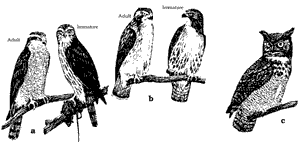|
Hawks and Owls | Hawk and Owl Overview | Hawk and Owl Damage Assessment | Hawk and Owl Damage Management | Hawk and Owl Resources | Hawk and Owl Acknowledgments | ICWDM | Wildlife Species Information |

Figure 1. Raptors, representative of those that may cause damage by preying on poultry and other birds, pets, and other animals: When two of the same species are pictured, mature birds on the left and immature birds on right. Pictured left to right.(a) the goshawk
(Accipiter gentilis), (b) red-tailed hawk, (Buteo jamaicensis), (c) great horned owl (Bubo virginianus).
Introduction
Hawks and owls are birds of prey and are frequently referred to as raptors— a term that includes the falcons, eagles, vultures, kites, ospreys, northern harriers, and crested caracaras. Food habits vary greatly among the raptors. Hawks and owls are highly specialized predators that take their place at the top of the food chain. Some are responsible for the loss of poultry or small game. In the past, raptors were persecuted through indiscriminate shooting, poisoning, and pole trapping. The derogatory term chicken hawk was used generically to identify raptors, especially hawks, but has fallen out of usage during the past two decades. Recently, many people have developed a more enlightened attitude toward raptors and their place in the environment.
People who experience raptor damage problems should immediately seek information and/or assistance. “Frustration killings” occur far too often because landowners are unfamiliar with or unable to control damage with nonlethal control techniques. These killings result in the needless loss of raptors, and they may lead to undesirable legal actions. If trapping or shooting is necessary, permits should be requested and processed as quickly as possible. Always consider the benefits that raptors provide before removing them from an area; their ecological importance, aesthetic value, and contributions as indicators of environmental health may outweigh the economic damage they cause.
General Biology
There are two main groups of hawks: accipiters and buteos. Accipiters are the forest-dwelling hawks. North American species include the northern goshawk (Accipiter gentilis), Cooper’s hawk (Accipiter cooperii), and sharp-shinned hawk (Accipiter striatus). They are characterized by distinctive flight silhouettes—relatively short, rounded wings and a long rudder like tail. Their flight pattern consists of several rapid wing beats, then a short period of gliding flight, followed by more rapid wing beats. Accipiters are rarely seen except during migration because they inhabit forested areas and are more secretive than many of the buteos.
The largest and least common, but most troublesome, accipiter is the goshawk (Fig. 1). It is a bold predator that feeds primarily on forest-dwelling rodents, rabbits, and birds. Occasionally, it is attracted by free-ranging poultry or large concentrations of game birds and can cause depredation problems. Its breeding range is limited to Canada, the northern United States, and the montane forests of the western United States. Spectacular autumn invasions of goshawks occur at irregular intervals in the northern states. These are probably the result of wide-spread declines in prey populations throughout the goshawk’s breeding range. Cooper’s hawks will occasionally cause problems with poultry; sharp-shinned hawks are rarely a problem because of their small size.
|
Hawks and Owls | Hawk and Owl Overview | Hawk and Owl Damage Assessment | Hawk and Owl Damage Management | Hawk and Owl Resources | Hawk and Owl Acknowledgments | ICWDM | Wildlife Species Information |
The buteos are known as the broad-winged or soaring hawks. They are the most commonly observed raptors in North America. Typical species include the red-tailed hawk (Buteo jamaicensis), red-shouldered hawk (Buteo lineatus), broad-winged hawk (Buteo platypterus), Swainson’s hawk (Buteo swainsoni), rough-legged hawk (Buteo lagopus), and ferruginous hawk (Buteo regalis). All buteos have long, broad wings and relatively short, fan-like tails. These features enable them to soar over open country during their daily travels and seasonal migrations.
The red-tailed hawk (Fig. 1) is one of our most common and widely distributed raptors. Redtails can be found over the entire North American continent south of the treeless tundra and in much of Central America. They demonstrate a remarkably wide ecological tolerance for nesting and hunting sites throughout their extensive range. Typical eastern redtails nest in mature forests and woodlots, while in the Southwest they often nest on cliffs or in trees and cacti. Their diet, although extremely varied, usually contains large numbers of rodents and other small mammals. Redtails occasionally take poultry and other livestock, but the benefits they provide in aesthetics, as well as in the killing of rodents may outweigh depredation costs. Other species of buteos rarely cause problems.
Owls, unlike hawks, are almost entirely nocturnal. Thus, they are far more difficult to observe, and much less is known about them. They have large heads and large, forward-facing eyes. Their flight is described as noise-less and moth like. There are 19 species of owls in the continental United States. They range in size from the tiny, 5- to 6-inch (12-to 15-cm) elf owl (Micrathene whitneyi) that resides in the arid Southwest, to the large, 24- to 33-inch (60-to 84-cm) great gray owl (Strix nebulosa) that inhabits the dense boreal forests of Alaska, Canada, and the northern United States.
The great horned owl (Bubo virginianus, Fig. 1) is probably the most widely distributed raptor in North America. Its range extends over almost all the continent except for the extreme northern regions of the Arctic. These large and powerful birds are considered to be the nocturnal complement of the red-tailed hawk. Great horned owls generally prey on small-to medium-sized birds and mammals and will take poultry and other livestock when the opportunity presents itself. They are responsible for most raptor depredation problems.
Scott E. Hygnstrom. Extension Wildlife Damage Specialist.
Department of Forestry, Fisheries and Wildlife University of Nebraska.
Lincoln, Nebraska 68583-0819
Scott R. Craven. Extension Wildlife Specialist Department of Wildlife Ecology. University of Wisconsin-Madison, Madison, Wisconsin 53706
